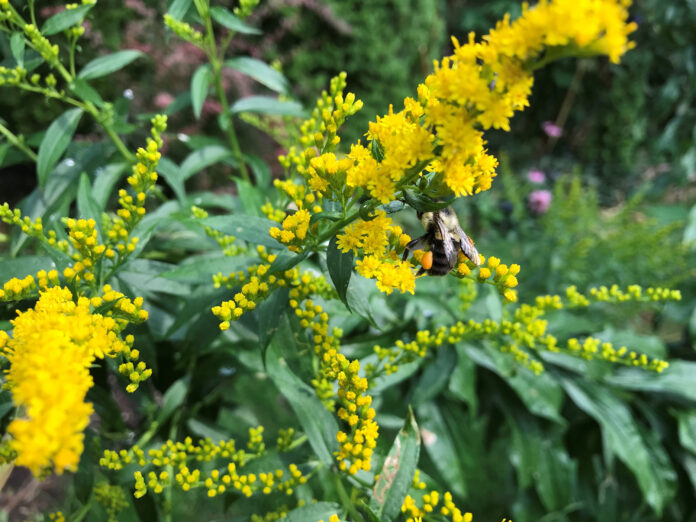By Mark and Ben Cullen – Gardening
Our opinion of what is beautiful can change. Ben looks at the fashion of the 70’s and laughs at the gaudy colours, men in long unkempt hair, sideburns. Hey, this was Mark back in the day. Careful son!
Milkweed has been in fashion for years. Years ago, it was an enemy garden weed. That is, until its relationship to the beloved monarch butterflies was brought to public attention. Today, we see milkweed seeds available for sale from most Canadian seed suppliers. From noxious weed to $1.99 a packet of seed in one generation.
This is a good thing – for the beautiful milkweed, for butterflies, for people and for the environment.
We believe goldenrod (Solidago spp.) is next to have its natural beauty redeemed in the court of public opinion.
One myth that plagues goldenrod is that people are allergic to it. The fact is ragweed is predominantly responsible for hay fever in much of North America. Goldenrod’s showy, pollen-rich yellow flowers happen to bloom in the same period. Guilt by association. Goldenrod flowers are sticky and do not blow in the wind.
Golden rod has some phenomenal traits.
Of the 120 or so species within the Solidago genus, about 80 are native to North America. By our standards, native plants cannot be weeds – they are wildflowers. See how we elevated their reputation just by changing the “w” word: from weeds to wildflowers?
Goldenrod herbal tea has been used as an anti-inflammatory medicine by First Nation communities since pre-settler times. Young goldenrod leaves are even edible on their own.
Humans aren’t the only ones who can consume goldenrod. Emily Damstra, a natural-science illustrator in Guelph, Ontario refers to goldenrod as “a biodiversity superhero”.
She explains, “Hundreds of different insect and spider species make use of goldenrod. One of my favourites is the caterpillar of the Goldenrod Hooded owlet moth—Cucullia asteroids. These lovely insects come in a few different colour morphs; I love encountering them because they’re like jewels hidden among the foliage and flowers. Goldenrod hosts many different caterpillar species, which is important because most of the terrestrial birds in North America feed their young primarily with caterpillars.”
Damstra spent a whole year studying goldenrod and the insects, spiders, and various other organisms supported by it, which culminated in three published articles and a whole series of scientific illustrations sold as artwork.
Another point about goldenrod is its value year-round, as Damstra illustrates in her series. “When Goldenrod are at their peak in late summer, numerous bees and other pollinators will be the first animal life you’ll see. Later this fall, you can still find insect larvae in among the seeds, and small spiders on patrol. In winter, a variety of galls that goldenrod hosts are evident, and in spring, signs of leaf miners are abundant.”
Galls are one of Ben’s favourite features of the goldenrod – those are the bulb-like growths on the stem that are induced by larvae of different insect species. Parasitic wasps in turn lay their eggs in the larvae, which feed on the plant from inside these bulbs. It is not uncommon for woodpeckers to feed on the insects living inside the gall, another display of ecological theatre.
Cultivated varieties are increasingly common, most of which thrive in full sun and moderate soil types. Now is a good time to divide any existing bunches you might have. ‘Fireworks’ goldenrod (Solidago rugosa) is a cultivar with arching flowers that appear to burst as the name implies, and Blue-stemmed goldenrod (Solidago caesia) is unique for its partial shade tolerance – a bright way to colour in some darker corners of the garden.
Of course, you can always find goldrenrod naturalized in ditches and meadows across its native habitat. This is a good time of year to enjoy the last golden splendour of the season. They are often found among Queen Anne’s Lace and New England Aster – the white, purple and yellow playing well off of one another in the wild: art in nature. Online, you can find Emily Damstra’s illuminating illustrations and further reading on the genus at www.emilydamstra.com/projects/goldenrod/
Mark Cullen is an expert gardener, author, broadcaster, tree advocate and Member of the Order of Canada. His son Ben is a fourth-generation urban gardener and graduate of University of Guelph and Dalhousie University in Halifax. Follow them at markcullen.com, @markcullengardening, and on Facebook.


